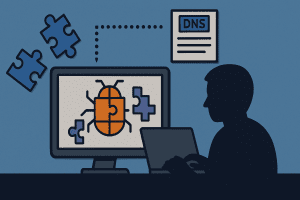 A new cybersecurity threat is emerging as attackers use DNS records—the very system that directs internet traffic—to hide malware. Instead of relying on email attachments or suspicious downloads, bad actors are embedding malicious payloads into DNS TXT records. This method sneaks malicious code past traditional defenses because security tools often ignore DNS traffic.
A new cybersecurity threat is emerging as attackers use DNS records—the very system that directs internet traffic—to hide malware. Instead of relying on email attachments or suspicious downloads, bad actors are embedding malicious payloads into DNS TXT records. This method sneaks malicious code past traditional defenses because security tools often ignore DNS traffic.
DNS, or Domain Name System, acts like the internet’s phonebook, translating domain names into IP addresses. It is so fundamental and routine that most security systems allow it without scrutiny. That makes it a perfect hiding place. According to researchers at Infoblox, attackers are disguising shellcode—malicious binary instructions—inside base64-encoded TXT records. These look like harmless text but are reassembled and executed by compromised devices once fetched. [Read more…]
 You click a link. It takes you to a site that looks exactly right. The logo matches, the name checks out, and everything feels familiar. But something’s off. And before you realize what it is, you’ve handed over your login, your credit card, or worse, your network credentials. The trick wasn’t in the layout or the content. It was in the letters.
You click a link. It takes you to a site that looks exactly right. The logo matches, the name checks out, and everything feels familiar. But something’s off. And before you realize what it is, you’ve handed over your login, your credit card, or worse, your network credentials. The trick wasn’t in the layout or the content. It was in the letters. A surveillance app marketed as a stealthy tool for parents has exposed sensitive data from over 62,000 users, raising fresh concerns about the real audience for apps like it.
A surveillance app marketed as a stealthy tool for parents has exposed sensitive data from over 62,000 users, raising fresh concerns about the real audience for apps like it. Email authentication continues to improve, but DMARC is still widely misunderstood and often misused. The number of domains publishing DMARC records has grown steadily since 2023, especially in industries like finance, education, and healthcare. However, a large percentage of those domains are not enforcing any policy, which means spoofing and phishing attacks are still a serious concern.
Email authentication continues to improve, but DMARC is still widely misunderstood and often misused. The number of domains publishing DMARC records has grown steadily since 2023, especially in industries like finance, education, and healthcare. However, a large percentage of those domains are not enforcing any policy, which means spoofing and phishing attacks are still a serious concern. Security researchers have identified two major exploits in the Secure Boot system, both capable of sidestepping one of the most important protections on modern PCs. Microsoft has issued a patch for one of them. The other remains untouched, even as it offers attackers a nearly universal method to bypass security during the startup process.
Security researchers have identified two major exploits in the Secure Boot system, both capable of sidestepping one of the most important protections on modern PCs. Microsoft has issued a patch for one of them. The other remains untouched, even as it offers attackers a nearly universal method to bypass security during the startup process.